#tarbosaurus bataar
Explore tagged Tumblr posts
Text

[ The skull of Tarbosaurus bataar, alongside artwork by palaeoartist Hank Sharpe. ]
"Homeland Security Investigations (HSI) returned an impressive collection of dinosaur fossils to Mongolia’s Ambassador to the United States, Batbayar Ulziidelger, at a ceremony at the Library of Congress on Aug. 3. The fossils were recovered through HSI investigations conducted by our offices in Arizona, New York, and Wyoming, and the collection was represented by a tyrannosaurus bataar skull, protoceratops fossil, alioramus skull, and saurolophus skull. The alioramus, which resembles a smaller version of a tyrannosaurus rex, is exclusively found in Mongolia – the source of many, extremely rare fossils. The specimen on display at the ceremony is considered one of the best-preserved fossils ever found of the dinosaur that lived approximately 70 million years ago.
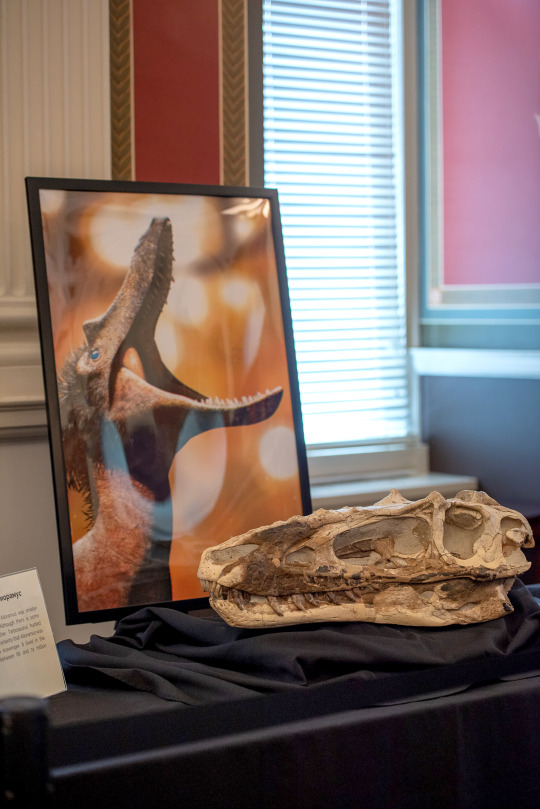

[ The skulls of Alioramus (left) and Protoceratops (right), alongside artwork by palaeoartist Hank Sharpe. ]
“Today’s event is dedicated to acknowledge the solid contributions of the officers and special agents from Homeland Security Investigations, U.S. attorneys, judges, scientists, and all individuals present here at ceremony as well as those who are absent due to their duty, who made this day possible,” said Ambassador of Mongolia Batbayar Ulziidelger. “This ceremony is a testament to the strong partnership between the Government of Mongolia and the Unites States and we are fortunate to witness the first-ever public display of these Mongolian dinosaur fossils.” “We have gathered here to witness the return of dinosaur fossils from the United States to their homeland – Mongolia; these fossils, once lost to time and distance, now find their way back to the land, where they were first discovered,” said Minister for Foreign Affairs of Mongolia Battsetseg Batmunkh. “The remarkable journey of these artifacts demonstrates the strength of collaborative diplomacy and a solid dedication to preserving our cultural heritage. I am delighted to acknowledge the valuable contributions of law enforcement officers and special agents, agencies, attorneys, judges… our collective efforts demonstrated the potential to effectively fight illegal smuggling, both bilaterally and multilaterally.” The first of these cases began in May 2012 when HSI New York initiated a cultural property investigation after receiving information alleging the illicit sale of protected fossils by a U.S.-based auction house. The investigation revealed that an individual, who later pled guilty to criminal counts of illegal importation of dinosaur fossils, was selling a fossilized alioramus skull through the auction house; that skull is part of the collection being returned. That same year, HSI Casper, Wyoming office received an HSI Tip Line report that a retail store was selling a fossilized tyrannosaurus bataar skull. HSI Casper began its investigation relating to the illegal importation and subsequent sale of dinosaur fossils originating from Mongolia, which has strong patrimony laws that prohibit the export of prehistoric fossils. These investigations led to multiple seizures of a wide range of paleontological fossils illegally taken from their country, including:a rare juvenile tyrannosaurus battar skull; a fossilized gallimimus skeleton; a tarbosaurus bataar skeleton; nests of dinosaur eggs; a saber-toothed cat skull; a complete psittacosaurus skeleton; and a protoceratops skull. Some of these dinosaurs lived more than 100 million years ago in an area now known as the Gobi Desert."
Read more: "HSI repatriates high-profile dinosaur fossils to Mongolia"
#Palaeoblr#Palaeontology#Paleontology#Fossils#Dinosaurs#Repatriation#Article#Tarbosaurus#Tarbosaurus bataar#Alioramus#Theropod#Protoceratops#Ceratopsian#Photos#Art#Cretaceous#Mesozoic#Prehistoric#Extinct
192 notes
·
View notes
Text
I'm so mad.
I was looking into tyrannosaur family trees, as one does, and was all like, hey, Tyrannosaurus and Tarbosaurus are considered sister taxons despite being on opposite sides of the world, what gives? How have we all missed this crucial fact!
I was thinking about it the past few days, and decided to make a passion project where I remade the tyrannosaur family tree with more intake from geography and what biology we had. Today I started it and was looking into papers, and then I remembered something. Beringia. The landmass that was once in place of the Bering Strait. It wasn't just open for migrations during the human migrations, but also in the Cretaceous period.
My passion project was ruined because I forgot about thE BERING STRAIT HBJGVHJHGVFHJHKCS
#tyrannosaurus rex#tyrannosaurus#tyrannosauroidea#tyrannosaurid#tyrannosaurs#tarbosaurus#tarbosaurus bataar#tyrannosaurus mcraeensis#phylogeny#phylogenetic trees#phylogenetic tree#phylogenetics#cladograms#cladogram#science#earth science#earth sciences#paleontology#paleontologist#aspiring paleontologist#this is why I will never be a paleontologist like I want to be#I'm so dumb#dumbass#dumbass scientist
10 notes
·
View notes
Text







Tarbosaurus bataar
(temporal range: 70 mio. years ago)
[text from the Wikipedia article, see also link above]
Tarbosaurus (/ˌtɑːrbəˈsɔːrəs/ TAR-bə-SOR-əs; meaning "alarming lizard") is a genus of tyrannosaurine theropod dinosaur that lived in Asia about 70 million years ago, during the Maastrichtian age at the end of the Late Cretaceous period, considered to contain a single known species: Tarbosaurus bataar. Fossils have been recovered from the Nemegt Formation of Mongolia, with more fragmentary remains found further afield in the Subashi Formation of China.
Although many species have been named, modern paleontologists recognize only one species, T. bataar. Some experts see this species as an Asian representative of the North American genus Tyrannosaurus, which would make the genus Tarbosaurus redundant. Tarbosaurus and Tyrannosaurus, if not synonymous, are considered to be very closely related genera. Alioramus, also from Mongolia, has previously been thought by some authorities to be the closest relative of Tarbosaurus, though this has since been disproven with the discovery of Qianzhousaurus and the description of the tyrannosaurine tribe Alioramini.
Like most known tyrannosaurids, Tarbosaurus was a large bipedal predator, with the type specimen measuring approximately 10 metres (33 ft) long, 3 metres (9.8 ft) tall at the hips, and weighing up to 4.5–5 metric tons (5.0–5.5 short tons). It had a unique locking mechanism in its jaw, equipped with about sixty large teeth, and the smallest arms relative to body size of all tyrannosaurids, renowned for their disproportionately tiny, two-fingered hands.
Tarbosaurus lived in a humid floodplain criss-crossed by river channels. In this environment, it was an apex predator preying on other large dinosaurs, like the hadrosaurids Saurolophus and Barsboldia or the sauropod Nemegtosaurus. Tarbosaurus is represented by dozens of fossil specimens, including several complete skulls and skeletons. These remains have allowed scientific studies focusing on its phylogeny, skull mechanics, and brain structure.
6 notes
·
View notes
Text
Monday Musings: The Tyrannosaur Family Tree
Tyrannosauridae is a family of coelurosaurian theropods from the Late Cretaceous Period. It is broken up into two subfamilies, Albertosaurinae and Tyrannosaurinae. Albertosaurinae consists of two genera: Albertosaurus sarcophagus
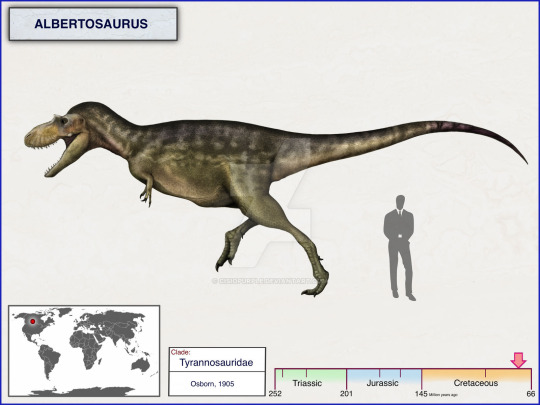
and Gorgosaurus liberatus.
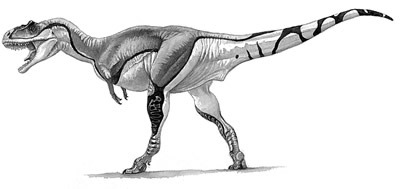
Tyrannosaurinae consists of Qianzhousaurus sinensis,
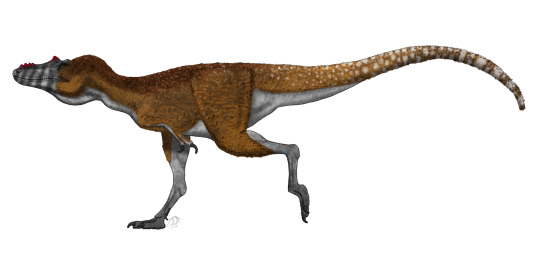
two species of Alioramus,
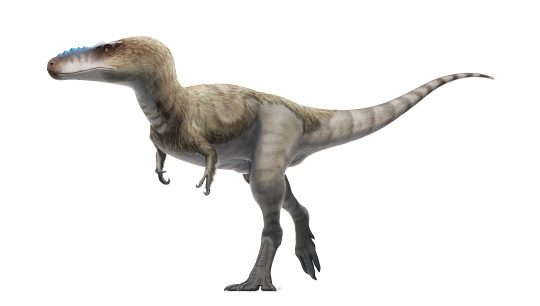
Nanuqsaurus hoglundi,
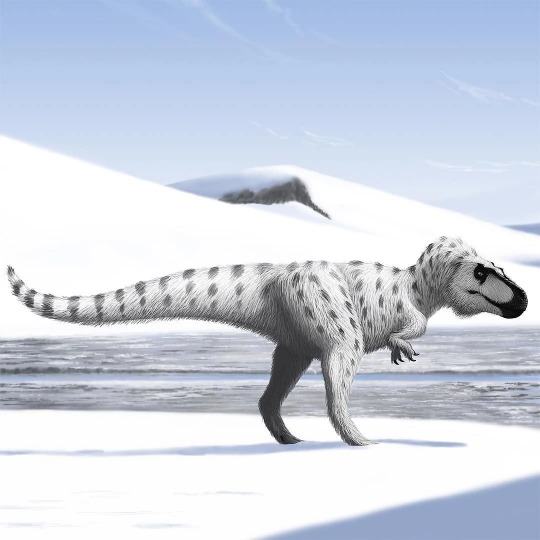
Teratophoneus curriei,
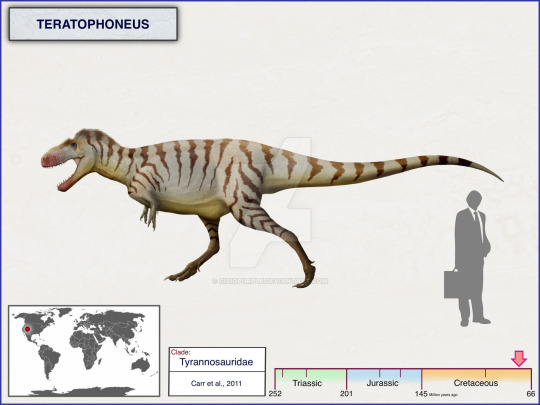
Lythronax argestes,
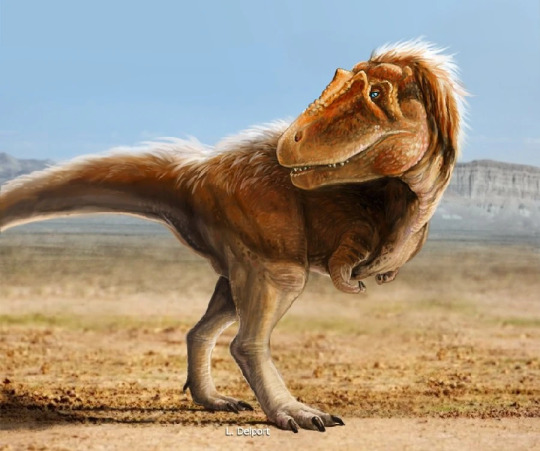
three species of Daspletosaurus,
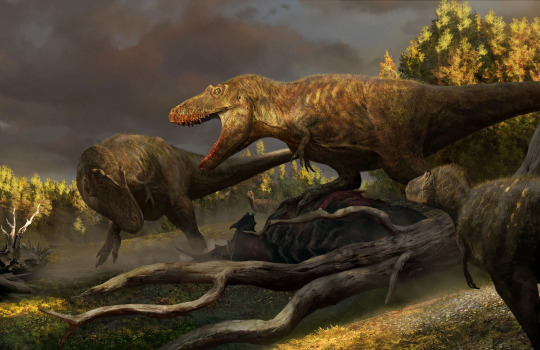
Zhuchengtyrannus magnus,
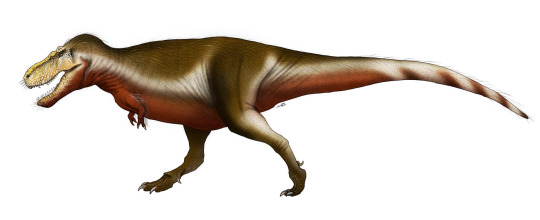
Tarbosaurus (or Tyrannosaurus) bataar,
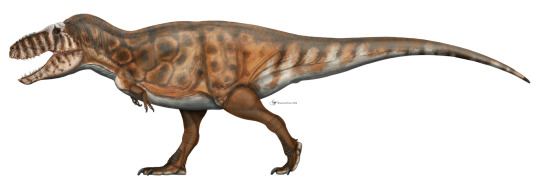
and at least two Tyrannosaurus species.
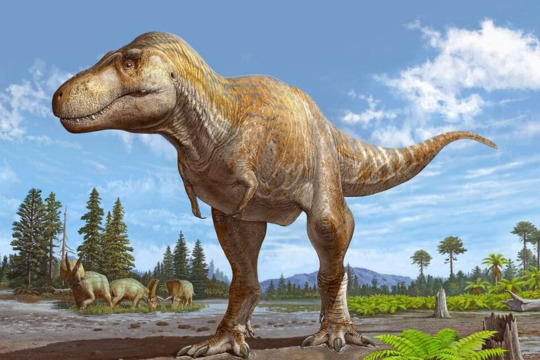
Notice a lot of similarities? Good, you should. Families should look similar. All tyrannosaurids were large-bodied animals capable of weighing a least 1 metric ton (2200 lbs). That's as much as a very large bull American Bison. Tyrannosaurid skulls are incredibly well known. Alioramus is the only one without a complete skull to study right now.
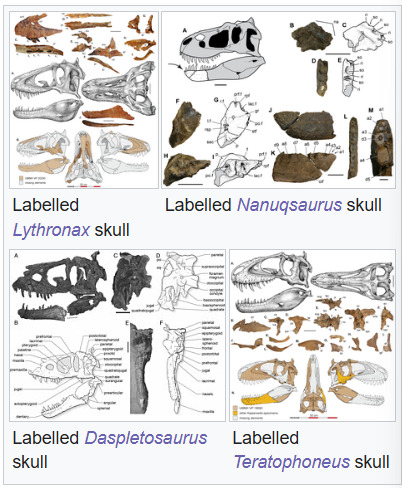
Adult tyrannosaurids had tall, massive skulls that were reinforced by fused pieces. They also had large fenestrae and hollow spaces to reduce the weight of such large skulls. They have many unique characteristics including fused parietal bones with a prominent sagittal crest and a tall nuchal crest (muscle attachments at the back of the head).
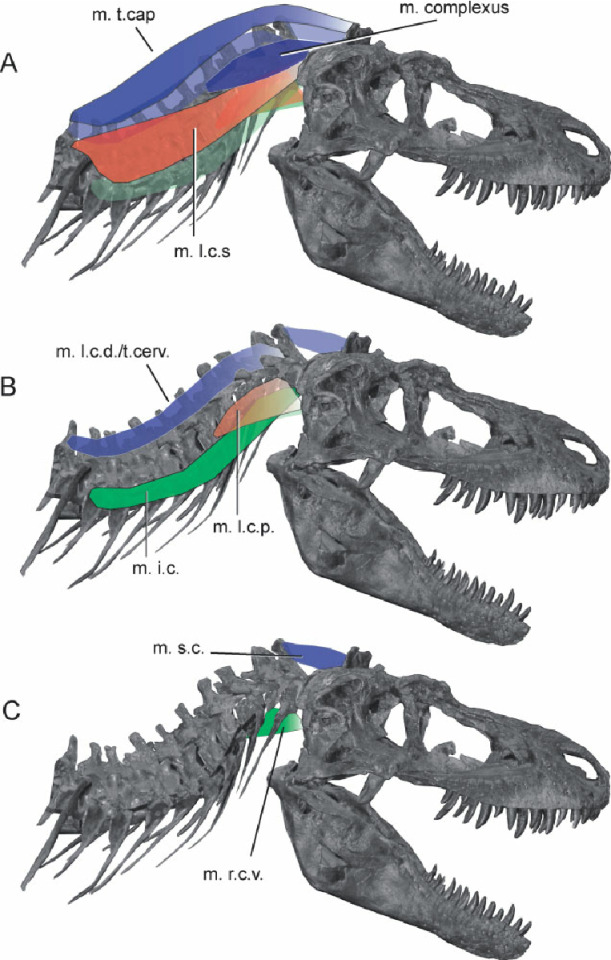
Tyrannosaurids had thick, s-curved necks to hold up their large heads as well as long, thick tails to act as a counterweight.
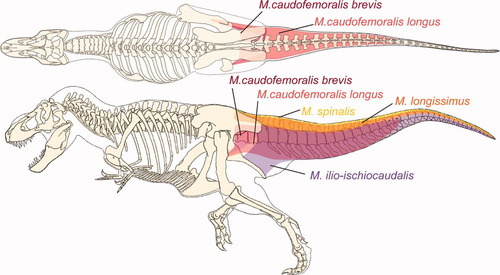
They also have proportionately small arms with two fingers.
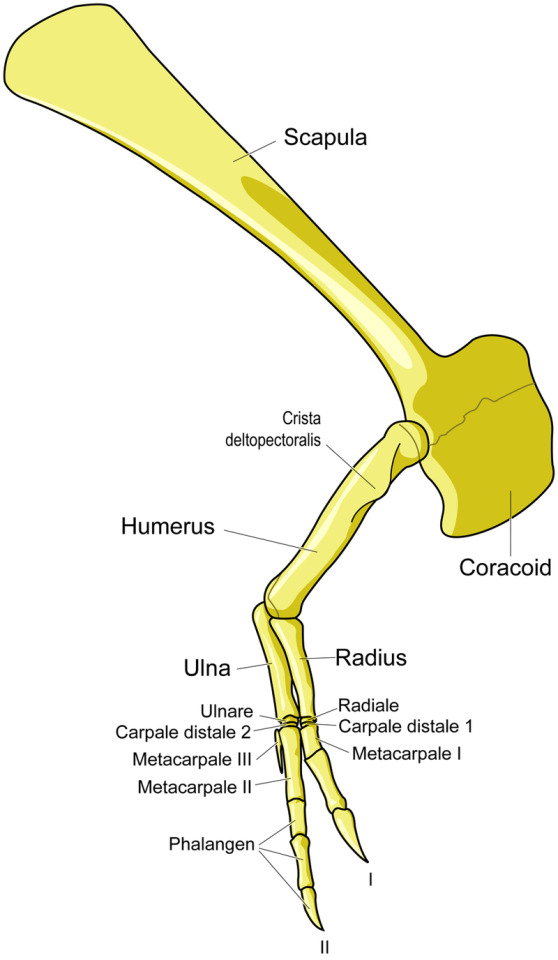
Soft tissue studies from the last few years also suggest that tyrannosaurids had lips to protect teeth from external damage.
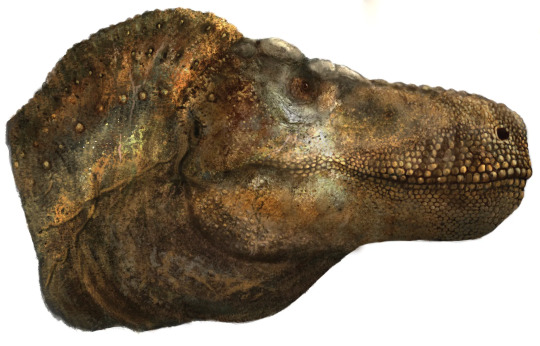
Tyrannosauridae is a family within the superfamily Tyrannosauroidea. This superfamily includes Coeluridae, dinosaurus like Compsognathus longipes,
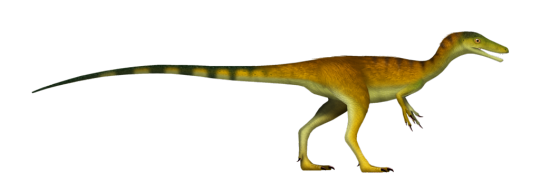
Proceratosauridae with dinosaurs like Sinotyrannus kazuoensis,
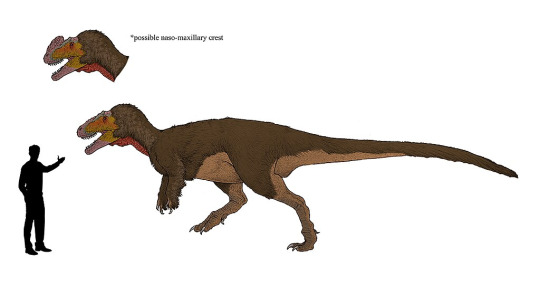
Megaraptorans like Megaraptor namunhuaiquii,
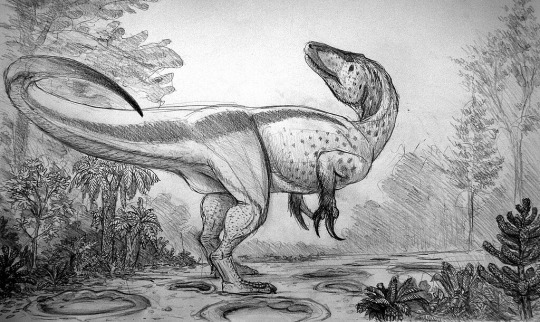
and Eutyrannosaurs like Appalachiosaurus montogomeriensis.
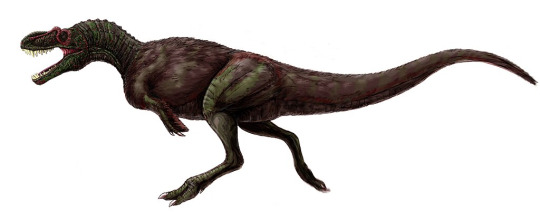
Altogether, they make quite a family portrait so make sure to tune in tomorrow to see if you were paying attention to today's lesson. Fossilize you later!
#paleontology#fossils#fun facts#dinosaur#science education#science#tyrannosaurs#tyrannosaurids#phylogeny#taxonomy
42 notes
·
View notes
Text



A Tarbosaurus bataar, with scars on the side of its body and a heavily damaged tail (either something bit it, or it was burned during a forest fire).
#anatomy studies#dinosaur anatomy#dinosaur#dinosaurs#dinosaur inking#dinosaur artwork#palaeoart#paleoart#artists on tumblr#theropod#tarbosaurus#tyrannosaur
42 notes
·
View notes
Text

Tantum's Construct 1-2
That’s right, your ol pal Sedge supports semiaquatic Deinocheirus theory
I’ve had to slowly stop adding paleontology jabs because they keep becoming irrelevant 😵💫 In the original version of the following chapter, two characters argue whether a third character was a Tarbosaurus or a Turannosaurus bataar (older refrance), which I updated into two characters arguing over whether a third character was a Saurophaganax or an Allosaurus maximus. It’s apparently a sauropod now, but Saurophaganax is already in the comic. Fortunately, I preemptively designed it to be my Allosaurus but a pallet swap!
What else is there to drone on about…? Well, those who have read further through another social medium might notice that these three are also the characters we follow for the BIG episode: chapter two. The only reason for this is that Monty and Cheira are characters created FOR this version of the story. They’re barely in the original paper version of chapter one, and have the combined personality of a paperclip. I really wanted to ensure that I knew them as characters before getting too far into the project. I probably should have done that in a pretend pitch Bible instead of making it up as I went, though! I paired both of them up with Tay because he’s one of the most developed characters, if not the most. He’s super easy for me to write for, and Monty has become a breeze as well. Cheira still evades me a little bit, and you’ll see her act a bit differently as we follow this and the next chapter, but she ends up as an anxious pick me girl who flips between having none and all of the confidence in the world, which I think makes her bounce off of my other characters very well
#comic art#dinosaur#graphic novel#paleoart#anime and manga#original character#original comic#tantum’s construct#cartoon#cartoonist
7 notes
·
View notes
Text

Native to the Late Cretaceous Nemegt Formation, Rinchenia mongoliensis was originally classified as a new species of Oviraptor before it was determined to be distinct enough to warrant its own genus. More complete than the Oviraptor holotype, Rinchenia was about the same size as its cousin, but less robust and sporting a large, domed, more highly-developed crest. Like Corythoraptor and modern day cassowaries, Rinchenia likely used its tall crest for display, heat-dissipation, and to detect low-frequency sounds. Like Oviraptor, it was probably an omnivore, and may have even used its sound-detection ability to locate burrowing prey.


Rinchenia lived in the Altan Uul locality of the Upper or Middle Nemegt with other oviraptorosaurs like Elmisaurus and Gobiraptor. It would have shared this seasonally arid landscape, broken up by cliffs, ravines, conifer forests, and shallow duckweed-filled lakes with other theropods like the alvarezsaurid Mononykus, the giant hump-backed ornithomimosaur Deinocheirus, a variety of birds, and the apex predator, the tyrannosaur Tarbosaurus bataar. Aside from seeds and nuts, Rinchenia may have also preyed on small lizards, mammals, and frogs like Altanulia.


This art may be used for educational purposes, with credit, but please contact me first for permission before using my art. I would like to know where and how it is being used. If you don’t have something to add that was not already addressed in this caption, please do not repost this art. Thank you!
#Rinchenia mongoliensis#Rinchenia#oviraptorid#oviraptorosaurs#theropods#saurischians#archosaurs#archosauromorphs#reptiles#SaritaDrawsPalaeo#Nemegt Formation#Late Cretaceous#Mongolia
27 notes
·
View notes
Text
LYRES REDESIGN SJSKDBFKF

Still not sure about fluff pattern and horns,but looks cool ig
Some info about them:
Full name: Lyretri Domino
Age: 23 yo (in dinotrux new gen they are 43)
Pronouses: any
Species: Tarbosaurus bataar half yutyrannus huali
But also has some giganotosaurus DNA
In Dinotrux, they would be a mix of the D-structs and Ty species (although they would somewhat resemble Ty in some appearance characteristics)
Character :
Usually quiet and silent, does not show emotions and usually has an emotionless or serious expression on his face, does not like being in large company, has basically had no contact with other creatures for a long period of time, has anxiety, although it is not visible because he does not show it, is introverted and has daddy issues.
Lyre is also a character included in my new Dinotrux au (still no name for it 🥲), they are Tenner's mother/parent :)
#dinotrux#artists on tumblr#drawing#art#draw#oc#dinotruxoc#fanart#myoc#tarbosaurusbataar#yutyrannushuali#hybrid#digitral art
6 notes
·
View notes
Photo

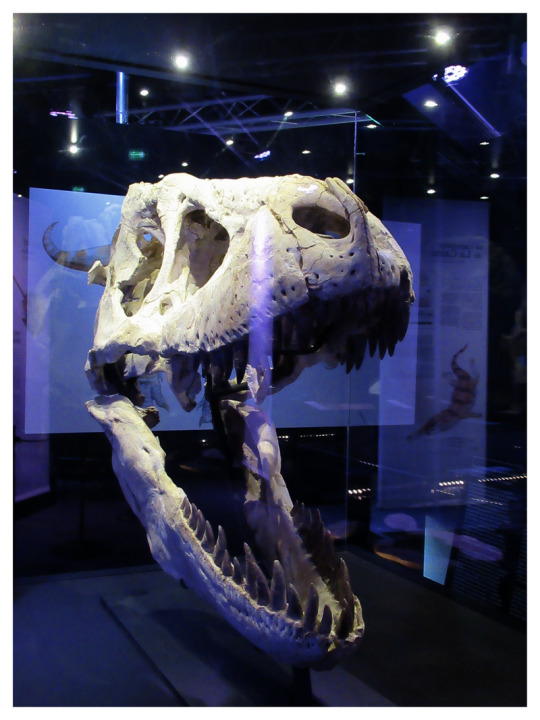
Tarbosaurus bataar | Late Cretaceous
Tarbo Mama’s skull is as big as me. A friendly reminder that I couldn’t survive Camp Cretaceous :’)
#Toro would chomp on me before the ferry leaves the island#tarbosaurus#camp cretaceous#paleontology#paleoblr#jwcc#jurassic park 30th anniversary
50 notes
·
View notes
Note
Two submissions:
Patchi
Pachyrhinosaurus lakustai
Walking With Dinosaurs 3D(2013)
and
Speckles
Tarbosaurus bataar
Speckles the Tarbosaurus
Patchi is already in, added Speckles! Thank you!
2 notes
·
View notes
Text
Tarbosaurus bataar (i don't exactly know why, but since my childhood it is. Maybe the name)
EVERYONE WHO SEES THIS HAS TO TELL ME WHAT THEIR FAVORITE DINOSAUR IS GO GO GO
9K notes
·
View notes
Text
favourite part about people having tried to make tarbosaurus bataar a species of tyrannosaurus instead is that regardless of its genus itd always be t-bataar, bro is not changing his legal documents fr
1 note
·
View note
Text
Dinofact #61
Tarbosaurus, a large tyrannosaurid dinosaur which is closely related to Tyrannosaurus, if not a synonym of Tyrannosaurus, is renowned for having the smallest forelimbs relative to body size of all Tyrannosaurids.
Source: Wikipedia
#dinosaur#dinosaurs#paleontology#tarbosaurus#tarbosaurus bataar#tyrannosaurus#tyrannosaurus rex#tyrannosaurid#tyrannosaurids#tyrannosaurinae#tyrannosauridae#tyrannosaurine#tyrannosaurines#theropod#theropods#theropoda#fun facts#trivia#dinosaur trivia#dinosaur fun facts#24th#october#2022#october 24th#october 2022#october 24th 2022
23 notes
·
View notes
Text
Wordplay Wednesday: Ending for taxonomic classifications
One Monday, you would have noticed I used several very large, very similar words. Today, I am going discuss and define a few: tyrannosauroidea, tyrannosauridae, tyrannosaurid, tyrannosaurinae, tyrannosaur, Tyrannosaurus. They all look pretty much the same, right? They do all have different meanings and references though.
First, tyrannosauroidea. This refers to the superfamily that encompasses several families including coelurians, proceratosaurids, megaraptorans, and eutyrannosaurs.

The suffix -oidea, means "like" or "resembling" so when combined with "tyrannosaur" it means "like or resembling tyrant lizards". This is tyrannosaurs and all their closest relatives. You may hear this in other contexts such as mineraloids (like minerals),

or metalloids (like metals).

Tyrannosauridae is a family within the superfamily tyrannosauroidea. Sometimes, we shorten it to tyrannosaurids. It also means "like or resembling" but in this case it is used to indicate a taxonomic family.

A British entomologist named William Kirby introduced the suffix as a way to standardize naming (which is extra important for someone who studies insects and other really small critters).

The suffix -inae is used to denote a subfamily. So, Tyrannosaurinae is a subfamily within the family Tyrannosauridae within the superfamily Tyrannosauroidea. Clear as mud, right?
Tyrannosaur is another short for so we don't have to right all these long words. Not that tyrannosaur is a short word but it is shorter than the other ones.

Finally, Tyrannosaurus is a genus within the subfamily tyrannosaurinae within the family tyrannosauridae within the superfamily tyrannosauroidea.
Oh, did I mention tyrannosaurini? Nope? Well, that is a tribe within the subfamily tyrannosaurinae. That tribe only includes Tarbosaurus (Tyrannosaurus) bataar, Tyrannosaurus rex and Tyrannosaurus mcraeensis.

So, in review:

Tune in tomorrow to learn about the man who named Tyrannosaurus rex. Fossilize you later!
#paleontology#fossils#dinosaur#fun facts#science education#science#tyrannosaurs#tyrannosauroidea#tyrannosauridae#tyrannosaurinae#tyrannosaurini#tyrannosaurus#science terminology
15 notes
·
View notes
Text
There is a long prehistory of exchange between Asian and NA ecosystems due to the on-off again connection of the Beringia land bridge.
The ones I'm most aware of are during the Cretaceous, which has at least a few connections through. While most Dinosaurs are generally monospecific, the genus Saurolophus has two species, one in Asia (Sa. angustirostris) and one in North America (Sa. osborni)

(A is Sa. angustirostris, B is Sa. osborni)

Since we have skin impressions of both we can also get a potential idea on Pattern based on how the scales are arranged (while not a certain tell it can be a sign) and those scale patterns suggest that the Asian species has a more striped or barred pattern, while the NA one may be more spotted or mottled.
Tyrannosaurus rex also a close relative (if not it's ancestors) appearing in Asia as well around the same time, Tarbosaurus bataar and Zhuchengtyrannus magnus (or Tyrannosaurus bataar and magnus depending on who you ask). While not much is known of Z. magnus, Tarbosaurus is pretty well studied. There's a lot of ecological difference between the two despite usually being placed as sister species to one another. Tyrannosaurus being much more specialized in delivering bone crushing bites with a wider skull and robust teeth while Tarbosaurus keeps a more basal condition of cutting teeth and slimmer skull, which likely has something to do with the different prey items both are dealing with in their respective ecosystems.
There's also the lone Asian Ceratopsid (an otherwise entirely NA endemic clade), Sinoceratops. Outside of this one species we're not sure if they managed to get a good foothold in Asian ecosystems, however I'd be surprised if it was entirely alone. Even compared to it's closest relative (Wendiceratops) we've found it's a very strange Ceratopsid, so they probably have some species between them we have yet to find.
There's a lot more taxa that exchanged during the Cretaceous, Earlier Ceratopsians such as Leptoceratopsids, Troodonts, Dromaeosaurs, and certainly a whole host of others I'm not as well versed in.
I don't mean it in a creepy way I promise, but I feel a kinship with China, Japan and Korea i wish more people from my region shared, because...we have sister ecosystems!
It's actually amazing, there are so many plant genera that are not closely related to anything else and just have a couple living species: One (or two) from mid latitude Southeast Asia, and one from the Southeastern USA.
For example, the two living lotus species (sacred lotus and American lotus), the two living tulip tree/ Liriodendron species, the Chinese and American sweetgums (Liquidambar spp.) the Chinese and American trumpet vines (Campsis spp.) the Chinese, Japanese and American wisteria (Wisteria spp), the Chinese, Taiwan and American sassafras (Sassafras spp.) I KNOW i'm forgetting many of them because there are so many. Twins!!!!
And there's so many iconic plant groups shared in common between East Asia and SE USA. Like dogwoods, magnolias, rhododendrons, we even have our own bamboo!!!
I think a lot of how strangely familiar each ecosystem would feel to someone visiting from the other one.
And I bet there's a lot of ecological knowledge and insights we could share with each other...
Sister ecosystems...
6K notes
·
View notes
Photo

Day 12 by NordicB3rry
#Tarbosaurus#Tarbosaurus bataar#Theropod#Tarchia#Dinosaurs#Prehistoric#Mesozoic#Cretaceous#Extinct#Art
25 notes
·
View notes